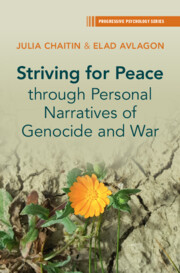178 results
8 - New Horizons of Mediation
- from Part III - Legal Metamorphosis?
-
- Book:
- Vanishing Legal Justice
- Published online:
- 20 March 2025
- Print publication:
- 03 April 2025, pp 164-172
-
- Chapter
- Export citation

Striving for Peace through Personal Narratives of Genocide and War
-
- Published online:
- 22 February 2025
- Print publication:
- 13 February 2025
Chapter 4 - Conceptualizations of Positive Peace and Reconciliation
- from Part I - Theoretical Background of the Book
-
- Book:
- Striving for Peace through Personal Narratives of Genocide and War
- Published online:
- 22 February 2025
- Print publication:
- 13 February 2025, pp 60-79
-
- Chapter
- Export citation
Driving policy dialogue on health technology assessment in Eastern Europe and Central Asia: reporting from an initiative of Health Technology Assessment International
-
- Journal:
- International Journal of Technology Assessment in Health Care / Volume 41 / Issue 1 / 2025
- Published online by Cambridge University Press:
- 06 February 2025, e12
-
- Article
-
- You have access
- Open access
- HTML
- Export citation
Chapter 5 - The British Novel of Ideas in an International Context
- from Part II - 1900–1945
-
-
- Book:
- The British Novel of Ideas
- Published online:
- 05 December 2024
- Print publication:
- 12 December 2024, pp 99-119
-
- Chapter
- Export citation
Chapter 6 - H. G. Wells
- from Part II - 1900–1945
-
-
- Book:
- The British Novel of Ideas
- Published online:
- 05 December 2024
- Print publication:
- 12 December 2024, pp 120-133
-
- Chapter
- Export citation

Beyond Civility in Social Conflict
- Dialogue, Critique, and Religious Ethics
-
- Published online:
- 08 November 2024
- Print publication:
- 27 June 2024
7 - From World War I to the Holocaust
- from Part III - 1800 to the Present Day
-
-
- Book:
- A Documentary History of Jewish–Christian Relations
- Published online:
- 03 October 2024
- Print publication:
- 17 October 2024, pp 341-396
-
- Chapter
- Export citation

A Documentary History of Jewish–Christian Relations
- From Antiquity to the Present Day
-
- Published online:
- 03 October 2024
- Print publication:
- 17 October 2024
Dialogue agents 101: a beginner’s guide to critical ingredients for designing effective conversational systems
-
- Journal:
- Natural Language Processing ,
- Published online by Cambridge University Press:
- 09 September 2024, pp. 1-39
-
- Article
-
- You have access
- Open access
- HTML
- Export citation
1 - The Three Voices in the Ethics of Communication
-
- Book:
- Beyond Civility in Social Conflict
- Published online:
- 08 November 2024
- Print publication:
- 27 June 2024, pp 19-64
-
- Chapter
- Export citation
6 - Sharing the Good News
-
- Book:
- Beyond Civility in Social Conflict
- Published online:
- 08 November 2024
- Print publication:
- 27 June 2024, pp 278-324
-
- Chapter
- Export citation
3 - Emoji in Healthcare Communications and Education
-
- Book:
- Emoji in Higher Education
- Published online:
- 30 May 2024
- Print publication:
- 06 June 2024, pp 56-82
-
- Chapter
- Export citation
Chapter 7 - Self-Investigation, Self-Knowledge, and Inner Conflict in Boethius’ Consolation of Philosophy
-
-
- Book:
- Boethius’ ‘Consolation of Philosophy’
- Published online:
- 23 May 2024
- Print publication:
- 30 May 2024, pp 116-134
-
- Chapter
- Export citation
Chapter 7 - Desire and Argument in Plato’s Gorgias
-
-
- Book:
- Plato's Gorgias
- Published online:
- 25 May 2024
- Print publication:
- 30 May 2024, pp 124-145
-
- Chapter
- Export citation
25 - Communicative Gesturing in Interaction with Robots
- from Part V - Gestures in Relation to Interaction
-
-
- Book:
- The Cambridge Handbook of Gesture Studies
- Published online:
- 01 May 2024
- Print publication:
- 18 April 2024, pp 641-660
-
- Chapter
- Export citation
Chapter 5 - Contradiction as Intrinsic to the Multiplicity of the Self
-
- Book:
- Entering the Moral Middle Ground
- Published online:
- 15 March 2024
- Print publication:
- 28 March 2024, pp 185-222
-
- Chapter
- Export citation
26 - Conclusion
- from Part IV - Emerging Trends
-
-
- Book:
- Deciphering the Genome of Constitutionalism
- Published online:
- 14 March 2024
- Print publication:
- 21 March 2024, pp 345-356
-
- Chapter
- Export citation
5 - Move 5: Weigh Trade-offs and Decide
-
- Book:
- Sorting It Out
- Published online:
- 18 January 2024
- Print publication:
- 29 February 2024, pp 149-178
-
- Chapter
- Export citation
2 - Move 2: Clarify What Matters
-
- Book:
- Sorting It Out
- Published online:
- 18 January 2024
- Print publication:
- 29 February 2024, pp 63-88
-
- Chapter
- Export citation




